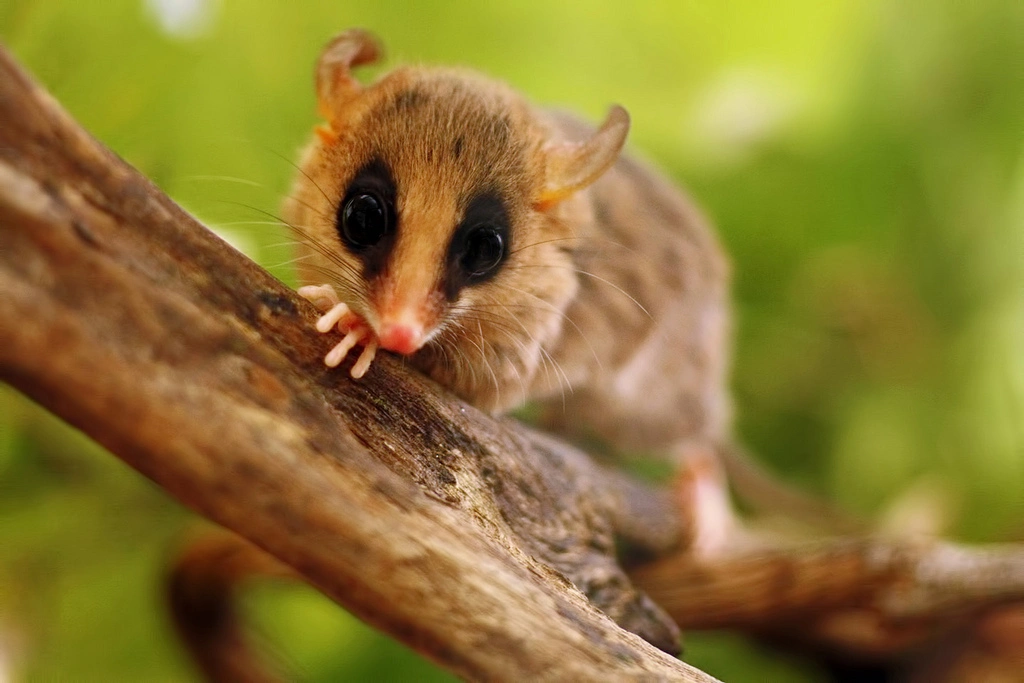The opossum (/əˈpɒsəm/) is a marsupial of the order Didelphimorphia (/daɪˌdɛlfɪˈmɔːrfiə/) endemic to the Americas. The largest order of marsupials in the Western Hemisphere, it comprises 103 or more species in 19 genera. Opossums originated in South America and entered North America in the Great American Interchange following the connection of the two continents. Their unspecialized biology, flexible diet, and reproductive habits make them successful colonizers and survivors in diverse locations and conditions.

The word "opossum" is borrowed from the Powhatan language and was first recorded between 1607 and 1611 by John Smith (as opassom) and William Strachey (as aposoum).[4] Both men encountered the language at the British settlement of Jamestown, Virginia, which Smith helped to found and where Strachey later served as its first secretary.[5] Strachey's notes describe the opossum as a "beast in bigness of a pig and in taste alike," while Smith recorded it "hath an head like a swine ... tail like a rat ... of the bigness of a cat."[5] The Powhatan word ultimately derives from a Proto-Algonquian word (*wa·p-aʔθemwa) meaning "white dog or dog-like beast."
The sum is also commonly known as a possum, particularly in the Southern United States and Midwest. Following the arrival of Europeans in Australia, the term "possum" was borrowed to describe distantly related Australian marsupials of the suborder Phalangeriformes,[6] which are more closely related to other Australian marsupials such as kangaroos.
Characteristics
Didelphimorphs are small to medium-sized marsupials that grow to the size of a house cat. They tend to be semi-arboreal omnivores, although there are many exceptions. Most members of this taxon have long snouts, a narrow braincase, and a prominent sagittal crest. The dental formula is: 5.1.3.4 / 4.1.3.4. By mammalian standards, this is an unusually full jaw. The incisors are very small, the canines large, and the molars are tricuspid.
Didelphimorphs have a plantigrade stance (feet flat on the ground) and the hind feet have an opposable digit with no claw. Like some New World monkeys, opossums have prehensile tails. Like all marsupials, the fur consists of awn hair only, and the females have a pouch. The tail and parts of the feet bear scutes. The stomach is simple, with a small cecum.[8] Like most marsupials, the male opossum has a forked penis bearing twin glandes.
Although all living opossums are essentially opportunistic omnivores, different species vary in the amount of meat and vegetation they include in their diet. Members of the Caluromyinae are essentially frugivorous; whereas the lutrine opossum and Patagonian opossum primarily feed on other animals.[11] The yapok (Chironectes minimus) is particularly unusual, as it is the only living semi-aquatic marsupial, using its webbed hindlimbs to dive in search of freshwater mollusks and crayfish.[12] The extinct Thylophorops, the largest known opossum at 4-7 kilos, was a macropredator.[13][14][15] Most opossums are scansorial, well-adapted to life in the trees or on the ground, but members of the Caluromyinae and Glironiinae are primarily arboreal, whereas species of Metachirus, Monodelphis, and to a lesser degree Didelphis show adaptations for life on the ground.
Behavior
Opossums are usually solitary and nomadic, staying in one area as long as food and water are easily available. Some families will group together in ready-made burrows or even under houses. Though they will temporarily occupy abandoned burrows, they do not dig or put much effort into building their own. As nocturnal animals, they favor dark, secure areas. These areas may be below ground or above.
When threatened or harmed, they will "play possum", mimicking the appearance and smell of a sick or dead animal. This physiological response is involuntary (like fainting), rather than a conscious act. In the case of baby opossums, however, the brain does not always react this way at the appropriate moment, and therefore they often fail to "play dead" when threatened. When an opossum is "playing possum", the animal's lips are drawn back, the teeth are bared, saliva foams around the mouth, the eyes close or half-close, and a foul-smelling fluid is secreted from the anal glands. The stiff, curled form can be prodded, turned over, and even carried away without reaction. The animal will typically regain consciousness after a period of a few minutes to four hours, a process that begins with slight twitching of the ears.
Some species of opossums have prehensile tails, although dangling by the tail is more common among juveniles. An opossum may also use its tail as a brace and a fifth limb when climbing. The tail is occasionally used as a grip to carry bunches of leaves or bedding materials to the nest.[30] A mother will sometimes carry her young upon her back, where they will cling tightly even when she is climbing or running.
Threatened opossums (especially males) will growl deeply, raising their pitch as the threat becomes more urgent. Males make a clicking "smack" noise out of the side of their mouths as they wander in search of a mate, and females will sometimes repeat the sound in return. When separated or distressed, baby opossums will make a sneezing noise to signal their mother. If threatened, the baby will open its mouth and quietly hiss until the threat is gone.